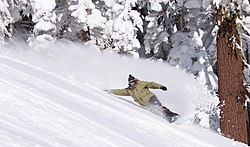Snowboarding: From the Beginning to a Popular Sport
Early History of Snowboarding: Evolution from Hobby to Extreme Sport
Snowboarding began in the 1960s as a form of recreation that combined elements of Surfing, skiing and skateboarding. Initially, the sport had no formal structure, with just a handful of people sliding down the slopes on simple boards without proper equipment.
In 1965, an engineer named Sherman Poppen created the “Snurfer,” which is considered the forerunner of the modern snowboard. A Snurfer is a board that is more like a skateboard without wheels, and is used for sliding on snow. Although it started out as just a children’s toy, the Snurfer’s popularity grew slowly, even holding small competitions.
Significant developments occurred in the 1970s when Jake Burton Carpenter, one of the sport’s pioneers, began developing more sophisticated snowboard designs. Burton modified the Snurfer board with the addition of toe ties, making it more stable and easier to control. This innovation paved the way for snowboarding as a more structured sport and attracted the attention of the ski community.
Despite initial resistance from the traditional ski community, snowboarding began to gain recognition in the 1980s. Large ski resorts that previously banned snowboarders on their slopes are starting to open their doors to the sport. Snowboarding competitions also emerged, including the first world championships held in 1983.
Snowboarding then experienced a surge in popularity during the 1990s. In 1998, snowboarding was officially recognized as a sport at the Winter Olympics in Nagano, Japan, marking its evolution from a simple hobby to a global extreme sport.
The Development of Snowboarding in the World: From Competition to the Olympics
Snowboarding began to grow rapidly in the early 1980s, after the modern snowboard was introduced by Jake Burton and Tom Sims. Despite initially facing resistance from traditional ski resorts, snowboarding continues to attract many people due to its freestyle and the excitement it offers.
The first competition in snowboarding was held in 1981 at Suicide Six Resort, Vermont, United States. This event was an important milestone in the world of snowboarding, as it introduced the sport to a wider audience. Since then, snowboarding competitions have grown in popularity, with more athletes and fans interested in taking part.
Rapid development occurred in the 1990s, when the International Snowboarding Federation (ISF) was founded. This federation organizes official competitions around the world, covering various categories such as freestyle and slalom. This provides formal structure and legitimacy to snowboarding as a competitive sport.
The peak of the development of snowboarding occurred in 1998, when snowboarding was first competed at the Winter Olympics in Nagano, Japan. This was a historic moment that put snowboarding on a par with other winter sports. Since then, snowboarding has become one of the most anticipated events at the Olympics, with categories such as halfpipe, slopestyle and big air continuing to attract the attention of a global audience.
Today, snowboarding is recognized as one of the greatest winter sports, with thousands of competitions and festivals around the world, and professional athletes continuing to push the boundaries in international events.
Snowboarding Pioneers: Important Figures in the History of This Sport
Snowboarding, which has now become one of the most popular winter sports, cannot be separated from the contribution of a number of important figures who shaped its initial development.
Sherman Poppen was one of the first pioneers in snowboarding history. In 1965, Poppen created the Snurfer, a simple board that is considered the ancestor of the snowboard. Originally created as a toy for children, the Snurfer became the basic foundation that inspired the development of the modern snowboard.
Jake Burton Carpenter is the most recognized figure in the world of snowboarding. In 1977, he founded Burton Snowboards and revolutionized the design of the Snurfer board by adding toe ties, which made the board’s control and stability much better. Jake Burton is considered to be the main pioneer who made snowboarding a global sport and created major competitions in this field.
Tom Sims also played a big role in the development of snowboarding. Sims, a professional skateboarder, helped introduce freestyle snowboarding, creating the freestyle trend in snowboarding. He also founded Sims Snowboards in 1983 and continues to promote snowboarding through board designs and competition events.
Dimitrije Milovich, a skier who turned to snowboarding, founded Winterstick Snowboards in the early 1970s. His company created several innovative board designs that were adopted by the snowboarding industry.
These pioneers not only created better equipment but also promoted snowboarding through competition, culture and innovation. Their contributions transformed snowboarding from a hobby to a globally recognized extreme sport.
Types of Snowboarding: Freestyle, Alpine and Backcountry
Snowboarding has evolved into a variety of disciplines that offer different challenges and styles. Three of the most popular are freestyle, alpine and backcountry.
Freestyle Snowboarding
Freestyle is a type of snowboarding that focuses on tricks, jumps and freestyle on snow. Snowboarders usually use snow parks which are filled with obstacles such as rails, boxes and halfpipes. This discipline allows for a high degree of creativity and technical ability, making it one of the most popular styles among young people. Competitions such as the X Games and Olympics also feature freestyle categories, including slopestyle and halfpipe.
Alpine Snowboarding
Alpine snowboarding, also known as hardboot snowboarding, focuses on speed and accuracy in descending slopes. In contrast to freestyle which emphasizes tricks, alpine is more structured and similar to racing skiing. The snowboard used is longer and narrower, with a hard boot to support better control when taking sharp turns at high speeds. This discipline is suitable for those who enjoy the technical challenge of conquering snow slopes at speed.
Backcountry Snowboarding
Backcountry involves snowboarding off the official resort trails, exploring mountains and untouched natural terrain. Backcountry snowboarders must have high technical skills as well as adequate equipment to deal with varying and often unpredictable snow conditions. This style offers freedom and a thrilling experience in the wild, but also requires extra preparation and vigilance due to risks such as avalanches and dangerous terrain.
Each of these types of snowboarding offers a different experience, depending on the rider’s preferences and skills.




